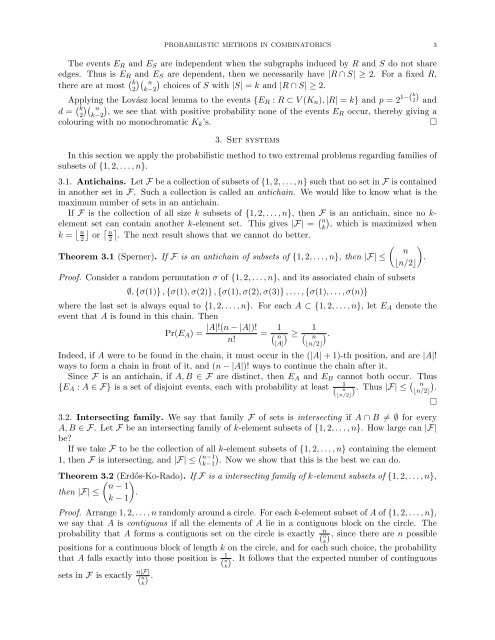PROBABILISTIC METHODS IN COMBINATORICS 1. Introduction ...
PROBABILISTIC METHODS IN COMBINATORICS 1. Introduction ...
PROBABILISTIC METHODS IN COMBINATORICS 1. Introduction ...
You also want an ePaper? Increase the reach of your titles
YUMPU automatically turns print PDFs into web optimized ePapers that Google loves.
<strong>PROBABILISTIC</strong> <strong>METHODS</strong> <strong>IN</strong> COMB<strong>IN</strong>ATORICS 3<br />
The events E R and E S are independent when the subgraphs induced by R and S do not share<br />
edges. Thus is E R and E S are dependent, then we necessarily have |R ∩ S| ≥ 2. For a fixed R,<br />
there are at most ( )(<br />
k n<br />
2 k−2)<br />
choices of S with |S| = k and |R ∩ S| ≥ 2.<br />
Applying the Lovász local lemma to the events {E R : R ⊂ V (K n ), |R| = k} and p = 2 1−(k 2) and<br />
d = ( )(<br />
k n<br />
2 k−2)<br />
, we see that with positive probability none of the events ER occur, thereby giving a<br />
colouring with no monochromatic K k ’s.<br />
□<br />
3. Set systems<br />
In this section we apply the probabilistic method to two extremal problems regarding families of<br />
subsets of {1, 2, . . . , n}.<br />
3.<strong>1.</strong> Antichains. Let F be a collection of subsets of {1, 2, . . . , n} such that no set in F is contained<br />
in another set in F. Such a collection is called an antichain. We would like to know what is the<br />
maximum number of sets in an antichain.<br />
If F is the collection of all size k subsets of {1, 2, . . . , n}, then F is an antichain, since no k-<br />
element set can contain another k-element set. This gives |F| = ( n<br />
k)<br />
, which is maximized when<br />
k = ⌊ n<br />
2<br />
⌋<br />
or<br />
⌈ n<br />
2<br />
⌉<br />
. The next result shows that we cannot do better.<br />
Theorem 3.1 (Sperner). If F is an antichain of subsets of {1, 2, . . . , n}, then |F| ≤<br />
( ) n<br />
.<br />
⌊n/2⌋<br />
Proof. Consider a random permutation σ of {1, 2, . . . , n}, and its associated chain of subsets<br />
∅, {σ(1)} , {σ(1), σ(2)} , {σ(1), σ(2), σ(3)} , . . . , {σ(1), . . . , σ(n)}<br />
where the last set is always equal to {1, 2, . . . , n}. For each A ⊂ {1, 2, . . . , n}, let E A denote the<br />
event that A is found in this chain. Then<br />
|A|!(n − |A|)!<br />
Pr(E A ) = = 1 1<br />
(<br />
n!<br />
n<br />
) ≥ ( n<br />
).<br />
|A| ⌊n/2⌋<br />
Indeed, if A were to be found in the chain, it must occur in the (|A| + 1)-th position, and are |A|!<br />
ways to form a chain in front of it, and (n − |A|)! ways to continue the chain after it.<br />
Since F is an antichain, if A, B ∈ F are distinct, then E A and E B cannot both occur. Thus<br />
1<br />
{E A : A ∈ F} is a set of disjoint events, each with probability at least<br />
( ⌊n/2⌋) . Thus |F| ≤ ( n<br />
⌊n/2⌋)<br />
.<br />
n<br />
3.2. Intersecting family. We say that family F of sets is intersecting if A ∩ B ≠ ∅ for every<br />
A, B ∈ F. Let F be an intersecting family of k-element subsets of {1, 2, . . . , n}. How large can |F|<br />
be?<br />
If we take F to be the collection of all k-element subsets of {1, 2, . . . , n} containing the element<br />
1, then F is intersecting, and |F| ≤ ( n−1<br />
k−1)<br />
. Now we show that this is the best we can do.<br />
Theorem 3.2 ( (Erdős-Ko-Rado). )<br />
If F is a intersecting family of k-element subsets of {1, 2, . . . , n},<br />
n − 1<br />
then |F| ≤ .<br />
k − 1<br />
Proof. Arrange 1, 2, . . . , n randomly around a circle. For each k-element subset of A of {1, 2, . . . , n},<br />
we say that A is contiguous if all the elements of A lie in a contiguous block on the circle. The<br />
probability that A forms a contiguous set on the circle is exactly<br />
( n , since there are n possible<br />
n<br />
k)<br />
positions for a continuous block of length k on the circle, and for each such choice, the probability<br />
1<br />
that A falls exactly into those position is . It follows that the expected number of continguous<br />
( n k)<br />
sets in F is exactly n|F|<br />
( n k) .<br />
□
















